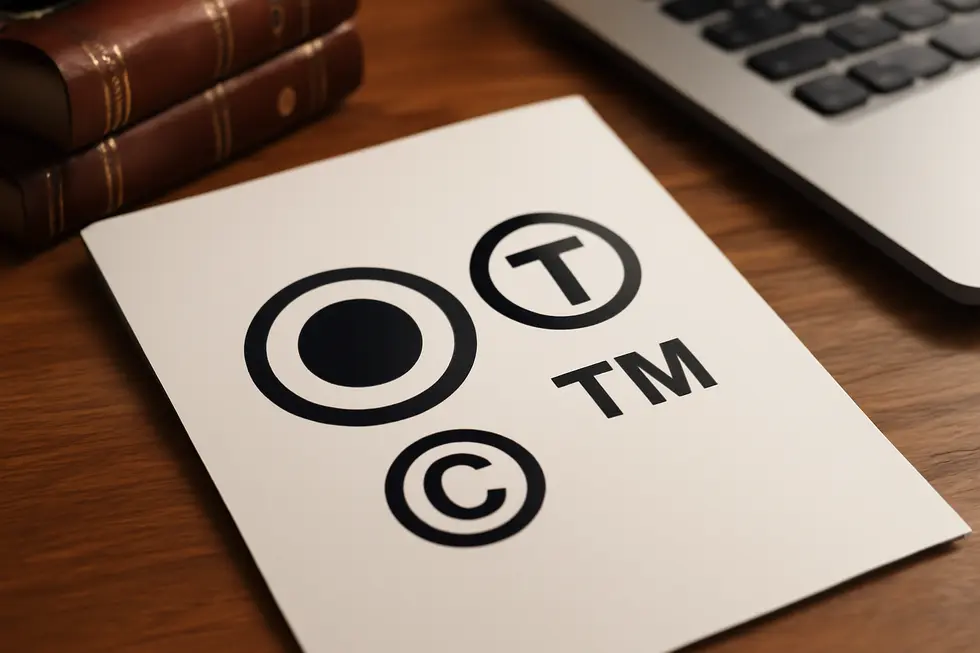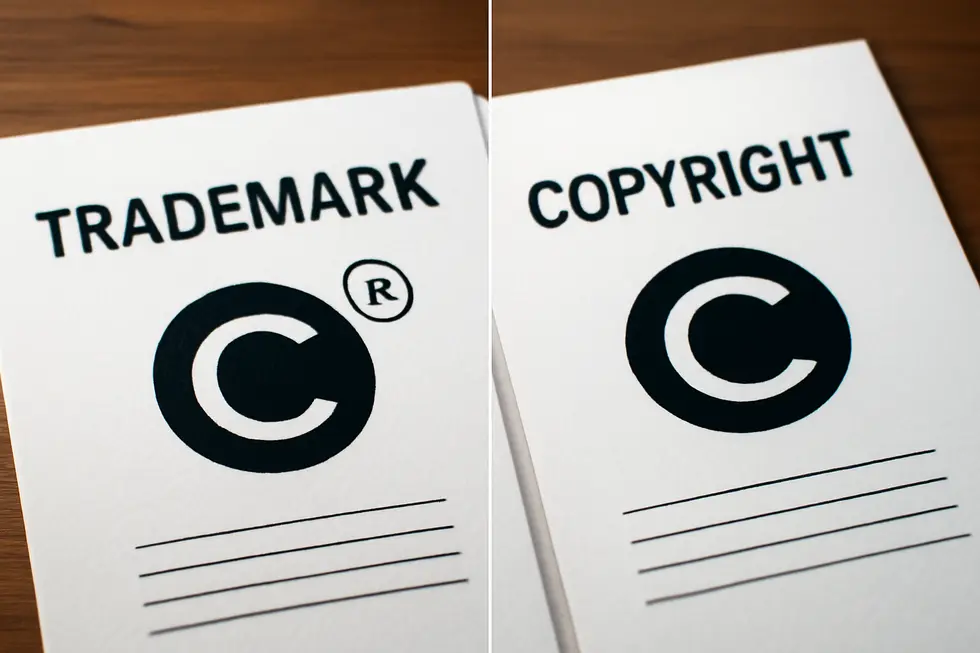Introduction
A company’s logo often serves as the visual cornerstone of its brand identity, creating a lasting impression on customers and distinguishing the business in competitive markets. For business owners, comprehending how to legally protect this vital asset through intellectual property (IP) laws is essential for preserving your brand’s uniqueness and value. Logos enjoy protection primarily through trademarks and copyrights, each addressing distinct legal dimensions to secure your creative and commercial interests. Exploring trademark protection reveals how logos function as brand identifiers and the indefinite safeguards trademarks provide when properly maintained. Delving into copyright protection clarifies the artistic aspect of logo design and its extended protection tied to the creator’s life span. Understanding legal symbols and registrations will empower you to denote your protections confidently and leverage official registrations effectively. Adopting a dual protection strategy combines the best of both worlds to maximize your logo’s security against infringement. Lastly, the process of trademark searches and registrations equips you with practical steps to ensure your logo’s distinctiveness and legal compliance. Together, these chapters build a comprehensive framework enabling business owners to protect their intellectual property logos with clarity and confidence.
Tables of Contents
Chapter 1: Trademark Protection for Intellectual Property Logo
- Harnessing Digital Technologies to Enforce Trademark Rights for Intellectual Property Logos
- Economic Benefits and Business Growth Driven by Trademark Protection
- Navigating Geopolitical Challenges in Trademark Protection for Intellectual Property Logos
- How Trademark Protection Shapes Society’s Trust and Fairness
Chapter 2: Copyright Protection and Intellectual Property Logo
- Harnessing Technology in Copyright Protection and Digital Enforcement of IP Logos
- Economic Impact of Copyrighted Intellectual Property Logos: Enhancing Brand Value and Market Position
- Navigating Global Copyright Complexities: International Laws and Cross-Border Enforcement of Intellectual Property Logos
- Shaping Culture and Awareness: The Societal Role of Copyright in Intellectual Property Logos
Chapter 3: Legal Symbols and Registration of Intellectual Property Logo
- Decoding ®, ™, and ©: Navigating Legal Symbols That Shield Your Intellectual Property Logo
- Navigating Federal Trademark Registration: Securing Comprehensive Legal Rights for Intellectual Property Logos
- How Copyright Safeguards the Creative Design Within Intellectual Property Logos
- Harnessing Legal Symbols and Registration to Strengthen Trademark Enforcement and Brand Identity
Chapter 4: Dual Protection Strategy for Intellectual Property Logo
- Integrating Legal Safeguards with Advanced Technologies in IP Logo Protection
- Economic Advantages of Dual Protection for Intellectual Property Logos
- Navigating Global Complexities in Dual IP Logo Protection
- The Societal Impact of Dual Trademark and Copyright Safeguards on Intellectual Property Logos
Chapter 5: Trademark Searches and Registrations for Intellectual Property Logo
- Mastering Trademark Searches: Essential Tools and Strategies to Secure Your Intellectual Property Logo
- Navigating the Trademark Registration Journey: Key Steps to Protect Your Intellectual Property Logo
- Securing Your Intellectual Property Logo: The Critical Role of Early Trademark Registration
- Harnessing Advanced Technologies for Exhaustive Trademark Logo Searches
Chapter 1: Trademark Protection for Intellectual Property Logo

1. Harnessing Digital Technologies to Enforce Trademark Rights for Intellectual Property Logos
The protection of intellectual property logos has evolved significantly with the adoption of digital technologies that enhance trademark enforcement. Advanced AI-driven monitoring tools scan enormous online spaces, including social media and e-commerce platforms, to detect unauthorized logo use or counterfeit products. These systems apply sophisticated image recognition algorithms capable of identifying even modified or disguised logos, enabling early intervention. Automated enforcement techniques, such as AI-generated takedown notices, accelerate removing infringing content, reducing manual oversight and response time. Beyond traditional trademarks, protecting dynamic marks like motion logos and sound marks demands innovative technological and legal approaches to establish distinctiveness. Digital watermarking and encryption embed ownership data directly into logo files, aiding in tracing misuse and securing digital assets. Integrating these tools into comprehensive brand protection platforms empowers businesses to safeguard their trademarks globally amidst increasing online complexity. However, these technological solutions complement, rather than replace, essential legal steps like trademark registration to establish exclusive rights and reinforce protection. For further insight into trademark strategies, see comprehensive trademark protection for business names and logos.
2. Economic Benefits and Business Growth Driven by Trademark Protection
Trademark protection of intellectual property logos is a critical driver of economic value and commercial stability. By legally distinguishing a company’s goods or services, trademarks build and preserve brand identity, fostering consumer trust that encourages loyalty and repeat business. This protection safeguards businesses from counterfeit products, which can undermine revenue, erode market share, and jeopardize employment. For instance, counterfeiting in regions like the EU has resulted in significant job losses and economic harm, highlighting the broader repercussions of weak trademark enforcement. Small and minority-owned businesses particularly benefit from trademark rights, as they secure the goodwill vital for expansion and competitive positioning. Moreover, trademarks are intangible assets that increase company valuation and can generate licensing revenue, attracting investment. Although legal enforcement can be costly, investing in trademark protection ultimately preserves market differentiation and supports sustainable growth. For deeper understanding of trademark’s business impact, see resources on trademark protection for businesses and logos.
3. Navigating Geopolitical Challenges in Trademark Protection for Intellectual Property Logos
Navigating Geopolitical Challenges in Trademark Protection for Intellectual Property Logos
Trademark protection for intellectual property logos must account for complex geopolitical dynamics that shape international enforcement and strategy. Different countries have distinct trademark systems, treaties, and enforcement mechanisms, making a one-size-fits-all approach ineffective. For example, while the Madrid Protocol streamlines multinational registrations, key countries like Canada and Mexico require separate filings, complicating protection in North America. Political tensions also influence trademark disputes; disputes linked to geopolitical conflicts can prolong or complicate enforcement, as seen in cases where national security concerns intersect with intellectual property rights. Customs and border authorities, especially in countries like China, play a vital role in policing trademark infringement, requiring registration with customs to prevent counterfeit imports. Furthermore, foreign investments in sensitive industries draw heightened governmental scrutiny, indirectly affecting trademark strategy. Because of these factors, companies must continuously monitor global trademark use and tailor enforcement approaches according to regional political and legal environments. For guidance on comprehensive trademark approaches, refer to detailed resources on trademark protection for business names and logos.
4. How Trademark Protection Shapes Society’s Trust and Fairness
Trademark protection of intellectual property logos plays a vital role beyond legal boundaries by fostering consumer trust and fair market practices. Logos act as immediate symbols of a brand’s identity, and protecting them prevents confusion caused by imitation. This assurance helps consumers confidently distinguish genuine products from counterfeits, shielding them from fraud and potential harm. Moreover, safeguarding logos supports businesses by preserving reputation and economic value, thus encouraging fair competition based on authentic quality and innovation. In our diverse cultural landscape, thoughtful enforcement respects differing social norms, balancing robust protection with the need to maintain positive public perception. The rise of digital platforms further complicates enforcement, requiring brands to navigate misuse while allowing creative expression such as commentary or parody. This dynamic protection framework nurtures a trustworthy marketplace where intellectual property rights bolster economic stability and innovation, reflecting the broader societal benefits of trademark laws. For comprehensive legal strategies on brand identity protection, explore trademark protection for business name and logo.
Chapter 2: Copyright Protection and Intellectual Property Logo

1. Harnessing Technology in Copyright Protection and Digital Enforcement of IP Logos
The digital age presents both opportunities and challenges for protecting intellectual property logos under copyright law. AI-generated logos raise complex questions about copyright eligibility, as current legal frameworks require meaningful human authorship to qualify for protection. This distinction ensures that the core of copyright remains tied to human creativity, even as AI tools play a growing role in design. Meanwhile, advanced AI-driven monitoring tools revolutionize enforcement by scanning immense digital platforms to detect unauthorized logo use and counterfeit products rapidly. Beyond traditional static symbols, technological innovation has fueled the rise of non-traditional trademarks, including motion and sound marks, which demand new strategies for registration and proof of distinctiveness. Legal battles over AI training data highlight the tension between leveraging technology and respecting creative rights, spurring legislative efforts toward transparent and balanced frameworks. Together, these technological and legal developments redefine how logos are created, protected, and enforced in a dynamic digital landscape. For more on trademark safeguards, see comprehensive insights on trademark protection for business names and logos.
2. Economic Impact of Copyrighted Intellectual Property Logos: Enhancing Brand Value and Market Position
Copyright protection imbues intellectual property logos with substantial economic significance by securing their unique creative design and reinforcing the brand’s identity. These protections transform logos into valuable intangible assets that elevate a company’s market valuation and consumer loyalty. By legally safeguarding original artistic elements, copyright ensures exclusive rights that bolster trust and distinguish products or services, effectively lowering marketing costs and fostering durable brand equity. Furthermore, the legal exclusivity granted restricts unauthorized use, enabling firms to control market access and maintain competitive advantage. While this exclusivity incentivizes innovation and supports long-term investment in brand development, it can also heighten barriers for smaller competitors due to enforcement expenses and complexity. Ultimately, the interplay between copyright protection and intellectual property logos shapes economic outcomes, balancing brand enhancement with strategic market control. For deeper insights into how copyright frameworks support business assets, see this copyright-language resource for business owners.
3. Navigating Global Copyright Complexities: International Laws and Cross-Border Enforcement of Intellectual Property Logos
The protection of intellectual property (IP) logos transcends national boundaries, requiring an understanding of international copyright laws and enforcement challenges. While treaties like the TRIPS Agreement, the Patent Cooperation Treaty, and the Madrid System offer frameworks to harmonize IP protections, enforcement remains reliant on individual countries’ legal systems and political will. This jurisdictional variability means a logo’s copyright protection may differ widely worldwide, demanding strategic approaches to registration and enforcement. Geopolitical pressures influence these dynamics, as developed nations encourage stronger IP regimes globally, yet disparities in enforcement capabilities persist. Additionally, digital innovation introduces complexities such as AI-generated designs and online infringement, complicating cross-border IP rights management. Businesses must carefully structure licensing to mitigate risks from differing regulations and geopolitical uncertainties. Balancing robust legal protection with ethical considerations about access and innovation highlights the nuanced geopolitical landscape surrounding copyright protection for intellectual property logos. For a deeper understanding of how to safeguard creative works, exploring copyright language for business owners can provide valuable insights.
4. Shaping Culture and Awareness: The Societal Role of Copyright in Intellectual Property Logos
Intellectual property logos embody more than just legal protection; they act as cultural symbols that foster deep connections with consumers and communities. Embedded within their designs are cultural cues that resonate differently across societies, influencing brand identity and loyalty. When companies adapt logos to reflect local custom or symbolism, they not only enhance cultural relevance but also build trust and authenticity. Copyright protection reinforces this by safeguarding the original artistic expression behind logos, underscoring the value of creativity and ownership in public consciousness. Legal frameworks like the Digital Millennium Copyright Act further shape societal respect for these rights by addressing infringement and piracy, especially in digital spaces. However, enforcement challenges and evolving technologies like AI require adaptive public awareness strategies. Overall, copyright and IP logos play a pivotal role in shaping cultural narratives, educating the public about intellectual property, and maintaining economic incentives for innovation. For businesses seeking detailed guidance on protecting brand designs, resources explaining copyright and trademark interplay offer valuable insights.
Chapter 3: Legal Symbols and Registration of Intellectual Property Logo

1. Decoding ®, ™, and ©: Navigating Legal Symbols That Shield Your Intellectual Property Logo
Intellectual property logos communicate ownership and protection status through three key legal symbols: ®, ™, and ©. The registered trademark symbol ® denotes a logo officially registered with a trademark office like the USPTO, granting exclusive nationwide rights and robust legal recourse against infringement. Only logos with registration can display this symbol legally. In contrast, the trademark symbol ™ signals a claimed trademark not yet registered. Although it asserts brand identity rights, its protection is limited to common law, meaning enforcement is geographically restricted and often challenging. Meanwhile, the copyright symbol © applies to the original creative design of the logo itself. While copyright protection automatically arises upon creation and fixation, the symbol serves as public notice, with registration enhancing legal enforceability. Together, these symbols clarify legal standing and help deter unauthorized use by signaling ownership type. Understanding their distinctions is vital for businesses seeking effective IP logo protection. For further insight, see detailed guidance on trademark protection for business names and logos.
2. Navigating Federal Trademark Registration: Securing Comprehensive Legal Rights for Intellectual Property Logos
Federal trademark registration through the United States Patent and Trademark Office (USPTO) grants exclusive nationwide rights to use a logo as a brand identifier tied to specific goods or services. This process begins with a careful search to confirm the logo’s uniqueness and proper classification under the Nice system. Applicants then file through the USPTO’s electronic system, providing detailed logo representations and paying fees per class. Following submission, the application undergoes rigorous examination to ensure compliance and address conflicts, with approved marks published for opposition. Once registered, the trademark owner gains critical legal presumptions, including the exclusive right to use the ® symbol, enhanced enforcement powers in federal courts, and nationwide priority over similar marks. These protections are vital for preventing unauthorized commercial use and building brand recognition. Coupling federal registration with copyright for the logo’s artistic design ensures robust intellectual property safeguards. For further insights into trademark protections for business names and logos, see related resources on trademark protection for business name and logo.
3. How Copyright Safeguards the Creative Design Within Intellectual Property Logos
Copyright protects the unique artistic expression embedded in intellectual property logos by securing the original visual elements from unauthorized copying. Unlike trademarks, which guard logos as brand identifiers in commerce, copyright focuses on the aesthetic and creative facets—such as shapes, colors, and distinctive graphic features—that make a logo original. This protection arises automatically upon creation, though registering the copyright grants stronger legal advantages, including clearer ownership proof and enhanced enforcement against infringement. While trademark registration with the USPTO ensures exclusive commercial use and prevents confusingly similar marks in the marketplace, copyright ownership enables control over the reproduction and distribution of the logo’s artwork itself. This dual protection is especially vital for legal symbols or law firm logos, where maintaining a logo’s artistic integrity reinforces its authority and exclusivity. Symbols like © denote copyright protection, signaling the original creative rights reserved. For businesses seeking robust logo protection, understanding the complementary role of copyright alongside trademark registration is essential; more information can be found in detailed resources on copyright laws for business owners.
4. Harnessing Legal Symbols and Registration to Strengthen Trademark Enforcement and Brand Identity
Effectively leveraging legal symbols such as ™, ®, and © plays a crucial role in protecting intellectual property logos. The ™ symbol identifies claims to a trademark before federal registration, serving as a public notice of intent though it offers limited enforcement power. Only after successful registration with the USPTO can the ® symbol be used, signaling registered status and unlocking stronger legal rights, including the ability to recover damages in infringement cases. Meanwhile, the © symbol protects the creative design elements of logos under copyright law but does not safeguard the logo as a brand identifier.
Trademark registration secures exclusive rights to use the logo in commerce, deterring others from confusingly similar uses and providing nationwide protection beyond limited common law rights. Yet, registration alone is insufficient; continuous enforcement through marketplace monitoring and legal actions is necessary to uphold these rights. Complementing trademarks with copyrights and, where applicable, design patents can enhance the overall protective strategy.
A well-informed approach to symbol usage, thorough registration covering potential product classes, and vigilant enforcement together empower businesses to defend their intellectual property logos effectively. For a deeper understanding of trademark protection strategies for logos, consult resources on trademark protections for business names and logos.
Chapter 4: Dual Protection Strategy for Intellectual Property Logo

1. Integrating Legal Safeguards with Advanced Technologies in IP Logo Protection
A robust dual protection strategy for intellectual property logos seamlessly combines trademark and copyright safeguards with cutting-edge technologies. Maintaining trademark rights for both legacy and redesigned logos preserves brand equity during transitions, while copyright secures the unique artistic elements. Technology-enabled monitoring systems track unauthorized logo use across digital and physical platforms, enabling swift enforcement and mitigating infringement risks. Coordinating trademark filings with marketing initiatives through specialized platforms ensures continuity in brand protection as new designs launch. Additionally, proprietary digital assets involved in logo creation—like design software or unique algorithms—are shielded via copyrights, patents, or trade secrets, supported by secure digital asset management. Emerging tools such as blockchain provide immutable proof of logo ownership and design history, reinforcing legal claims. Augmented reality or AI-driven branding extensions linked to logos also benefit from tailored IP strategies, backed by these technologies. Regular IP audits using integrated management software confirm that trademarks and copyrights remain current and enforceable, blending legal rigor with technological precision for comprehensive brand defense. For further insights on protecting logos through trademark law, explore this detailed resource on trademark protection for businesses.
2. Economic Advantages of Dual Protection for Intellectual Property Logos
Implementing a dual protection strategy for intellectual property logos delivers significant economic benefits by preserving brand equity and enhancing revenue potential. Securing rights over both legacy and contemporary logo designs ensures that valuable brand goodwill is maintained, preventing dilution that can arise during transitions. This continuous protection minimizes consumer confusion and safeguards market position, which translates into sustained commercial value. Additionally, enforcing dual rights enhances the company’s ability to deter unauthorized use and infringement, reducing costly legal risks and protecting revenue streams. Beyond defense, dual protection opens licensing opportunities, monetizing logos while influencing market dynamics to the company’s advantage. Integrated within a comprehensive IP portfolio, this strategy also bolsters competitive positioning and supports tactical business collaborations. Companies adopting this approach must consider associated financial and tax implications to optimize net returns. Ultimately, dual protection not only secures brand identity but also transforms intellectual property logos into robust economic assets, exemplified by firms that harmonize tradition with innovation through this approach. For more details on trademark safeguards, explore the insights on trademark protection for business names and logos.
3. Navigating Global Complexities in Dual IP Logo Protection
Navigating Global Complexities in Dual IP Logo Protection requires balancing legal safeguards with geopolitical realities. Intellectual property laws vary widely across countries, with differences in trademark systems and enforcement rigor demanding tailored strategies. Leveraging international treaties like the Madrid System streamlines multi-jurisdictional registrations, but local legal expertise remains essential to address unique regional challenges. Companies often maintain rights in both legacy and new logos to preserve brand equity and signal innovation, carefully coordinating filings and marketing to prevent dilution or infringement—especially amid market or political shifts. Further complexities arise from geopolitical tensions affecting supply chains and technology ecosystems, where IP enforcement intensity and licensing risks differ markedly. Effective dual protection thus blends centralized policy with adaptive local execution, incorporating licensing agreements that mitigate risks tied to regulation and political instability. This comprehensive approach ensures brands maintain legal strength and resilience across diverse international markets, protecting both commercial value and creative assets. For detailed guidance on trademark enforcement, see trademark protection business name logo.
4. The Societal Impact of Dual Trademark and Copyright Safeguards on Intellectual Property Logos
The dual protection strategy for intellectual property logos—combining trademark and copyright safeguards—plays a vital role beyond legal defense, deeply influencing societal perceptions and market dynamics. By preserving legacy logos through trademarks while securing creative designs with copyright, businesses maintain brand continuity and heritage. This dual approach builds consumer trust by reassuring customers that familiar brand elements remain authentic despite evolutions. It also curbs trademark dilution risks exacerbated by digital platforms, preventing confusion from unauthorized imitations or parodies that can erode brand distinctiveness. On a broader level, this carefully layered protection supports a stable commercial environment where innovation coexists with cultural respect. It enables companies to harmonize global brand portfolios while honoring regional legal and cultural differences, facilitating international trade and cultural sensitivity. Overall, the dual strategy nurtures both economic vitality and consumer confidence, ensuring logos remain meaningful symbols of quality and trust across changing markets. For more about securing brand identity, see our detailed guide on trademark protection for business names and logos.
Chapter 5: Trademark Searches and Registrations for Intellectual Property Logo

1. Mastering Trademark Searches: Essential Tools and Strategies to Secure Your Intellectual Property Logo
Conducting a thorough trademark search is foundational to protecting an intellectual property logo from infringement risks. The process begins with manual checks through authoritative databases such as the USPTO’s Trademark Electronic Search System (TESS), which lets users analyze both word and design marks across relevant trademark classes. This step uncovers direct conflicts and familiarizes one with similar registrations within the industry. However, manual methods may overlook subtle yet significant design similarities or phonetic overlaps.
To address these gaps, AI-powered platforms integrate advanced image recognition and linguistic algorithms, scanning global trademark databases to highlight potential visual and conceptual conflicts. These digital tools evaluate logo elements like shape, color, and layout, going beyond textual matches to ensure a more accurate risk assessment. Combining manual searches with such AI technologies guarantees coverage of all relevant trademark classes and variations, helping businesses safeguard their brand identities comprehensively.
Documenting this detailed search process proves invaluable for future legal verification and trademark defense. For more insights into protecting brand identifiers like logos, explore trademark protection for business names and logos.
2. Navigating the Trademark Registration Journey: Key Steps to Protect Your Intellectual Property Logo
Registering a trademark for your intellectual property logo is a meticulous process essential for securing exclusive brand rights. It begins with a comprehensive trademark search—using databases like USPTO’s TESS—to confirm your logo’s uniqueness and avoid conflicts. The application must then detail your logo’s design features, color scheme, and the specific goods or services it represents, classified according to accepted systems such as the Nice Classification. Submission requires official documents, including identification and a colored depiction of the logo. Once filed and fees are paid, the trademark office examines the application, potentially requesting clarifications or raising objections that require timely responses. Successful examination leads to public publication, allowing others the opportunity to contest within a set period. If no opposition arises or objections are resolved, the registration certificate is issued, granting robust legal protection and strengthening your brand’s market position. Early filing and professional guidance can significantly smooth this journey. For further insight on protecting your brand identity, explore common-law trademark rights.
3. Securing Your Intellectual Property Logo: The Critical Role of Early Trademark Registration
Early registration of an intellectual property logo is essential to secure comprehensive protection and establish clear legal rights. By initiating the trademark search and registration process promptly, businesses gain nationwide exclusive rights, which common law protections alone cannot assure. Filing early locks in a priority date based on intent to use, providing crucial leverage in potential disputes and serving as a foundation for lasting brand exclusivity. This proactive approach prevents competitors from adopting confusingly similar marks that could undermine brand reputation or weaken consumer trust. Additionally, registered trademarks allow use of the ® symbol, offering stronger deterrence against infringement and access to federal courts for enforcement. From a business perspective, early protection enhances the logo’s value as a marketable asset, attracting investors and enabling licensing opportunities. Conducting thorough trademark searches ahead of registration also mitigates risks of costly legal conflicts and registration refusals. Businesses aiming to fortify their logos with robust intellectual property rights will benefit from understanding these advantages, making early registration a strategic imperative. For insights on protecting your brand identity, refer to in-depth resources on trademark protection for business names and logos.
4. Harnessing Advanced Technologies for Exhaustive Trademark Logo Searches
Efficient trademark searches for intellectual property logos leverage a blend of official databases and cutting-edge AI technologies to ensure comprehensive coverage. Central to this process is the use of national registries like the USPTO’s Trademark Electronic Search System (TESS), complemented by international databases such as WIPO and EUIPO. These platforms enable detailed text and design mark queries, but modern search strategies extend far beyond them. Artificial intelligence enhances these efforts through natural language processing and sophisticated image recognition, detecting phonetic, semantic, and visual similarities that could signal conflicts. Specialized AI tools scrutinize logos for subtle design overlaps missed by manual searches, ensuring originality. Crucially, searches incorporate common law sources like social media, domain records, and business directories to uncover unregistered uses that may pose risks. This multi-dimensional approach not only identifies potential infringement issues but also supports strategic portfolio management by revealing relevant ownership details and application statuses. For robust trademark protection aligned with your marketing, integrating AI-driven searches with official registry checks is indispensable. To explore trademark protection strategies for business logos, see this guide on trademark protection for business name and logo.
Final thoughts
A logo is more than just an image; it is a key intellectual property asset representing the identity and reputation of your business. Protecting your logo through trademark and copyright laws empowers you to control how it is used, preventing others from capitalizing on your hard-earned brand equity. Recognizing the distinct but complementary roles of trademarks and copyrights allows you to defend both the commercial and creative aspects of your logo. Applying legal symbols and securing official registrations send a clear message about your ownership and readiness to enforce your rights. Employing a dual protection strategy fortifies your position and broadens your legal arsenal against various forms of infringement. Conducting diligent trademark searches and navigating the registration process methodically ensure that your logo stands strong as a protected symbol of your business. By investing time and resources into understanding and applying intellectual property protections, business owners can safeguard their logos effectively, securing their brand’s future and competitive edge.
Your IP is the foundation of your success – let’s protect it together before it’s too late. We can’t wait to help you turn your ideas into legally secured assets.
About us
undefined


